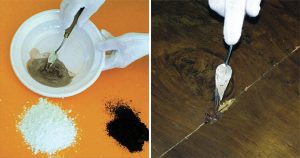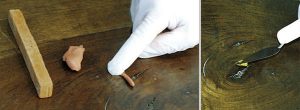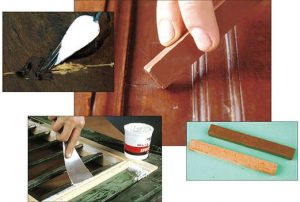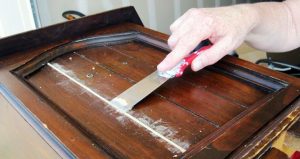Wood filling
Using filler or putty is done to fill holes and cracks in the wood.
It is a good rule of thumb not to fill holes or excessively large gaps, as with time and movement of the wood the filler tends to detach itself, so it is important to evaluate which are the imperfections that should be filled with putty and which ones should be filled by gluing strips or pieces of wood .
There are various types of filler and various ways of preparing it and using it, depending on the surface of the article and of its position inside or outside, such as doors and windows. In this session only a few types will be examined, those which are most used in small carpentry work and amateur restoration.
[bullet_list icon=”play” indent=”10px” style=””]
Stucco With plaster of Bologna (or carpenter’s chalk) – this stucco is used by professional restorers.
- It is a refined stucco that is obtained by mixing plaster of Bologna with animal glue (in one variation it is made with white glue). It should be used before the finishing and its durability depends on the amount of glue used. An excessive amount of glue will make the sanding more difficult.
The filler is mixed with a flexible spatula using as a basis a piece of marble, a tile or of painted wood and coloured earth is added to give it the colour of the planned finish. The mixture must not be too soft or too dense or it will be difficult to apply. If it is too dense it can be softened with a bit of water.
Once the mixture is ready it is applied into the holes and crevices, being careful that the stucco goes well into the imperfections and removing any excess with the spatula.
Once it is well dried it should then be sanded along the grain using a medium grit (120/150). The operation should be repeated in the event that the filler shrinks during the drying process.
- Chemical Stucco. Perhaps the most widely used stucco in renovation is ready mixed putty, which can be found in shops selling timber or paint. It should be used before the finishing phase.
The mix is prepared by taking the putty and adding water and coloured earths (‘mordant’ or natural colouring agent which are already dissolved in water), if desired a bit of white or PVA glue can be added to make the mixture even more tenacious, but in this case too it will make sanding more challenging.
The mixture should be stirred well together until a smooth paste of medium density has been obtained. It is then applied in the imperfections and allowed to dry thoroughly. Sanding should then be done with medium grit paper (120/150). Repeat if necessary.
- Stucco prepared in the workshop. A good filler can be hand-made on the work premises. Fine saw dust is required, possibly of the same type of wood of the furniture that is going to be filled, chemical putty, coloured earth and glue. It should be used before the finishing phase.
Prepare a mixture with half-and-half sawdust filler (if the result is not as desired, ratio can be changed), add the usual coloured earth (or mordant) and glue although the amount should be limited so as not to make the sanding too difficult. Apply in imperfections and allow to dry.
- Wax Stucco – They are putties made of wax, in stick form of various colours so they can be used with the various types of wood.
From the stick the required amount of filler is taken, with the help of a knife, and heated up with the fingers until it becomes malleable. Once softened it is placed into the holes or gaps and the excess is removed with a spatula, then polished with a soft cotton cloth.
Wax fillers should only be used to correct imperfections that may come to light once the finishing process is complete. They should not to be used before the finish, that is, instead of the chemical putty. It is important to know that the real stucco colour is what is visible when it is still wet. It will change as it dries and then resume its true colour during the finishing phase (that is, when treated with mordant, or shellac or coloured finishes).
[/bullet_list]




